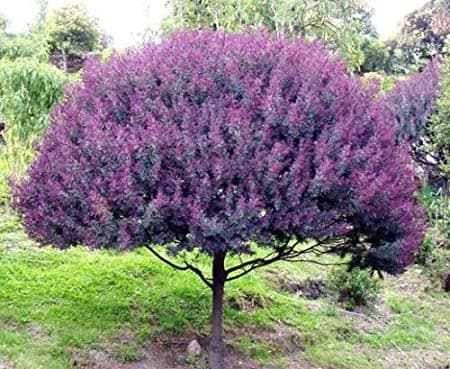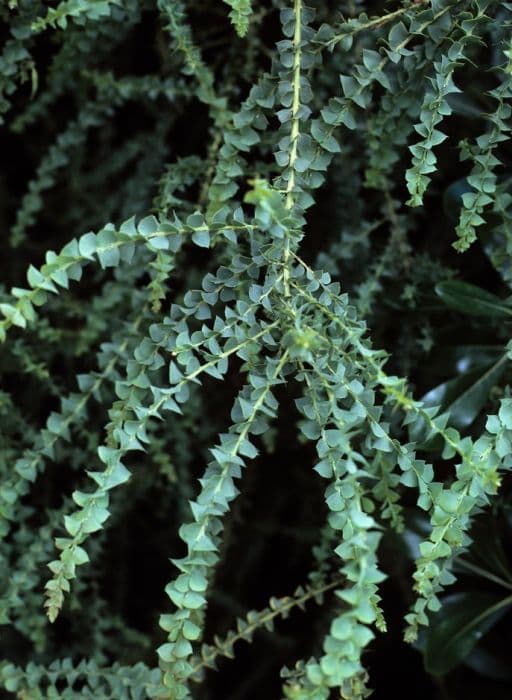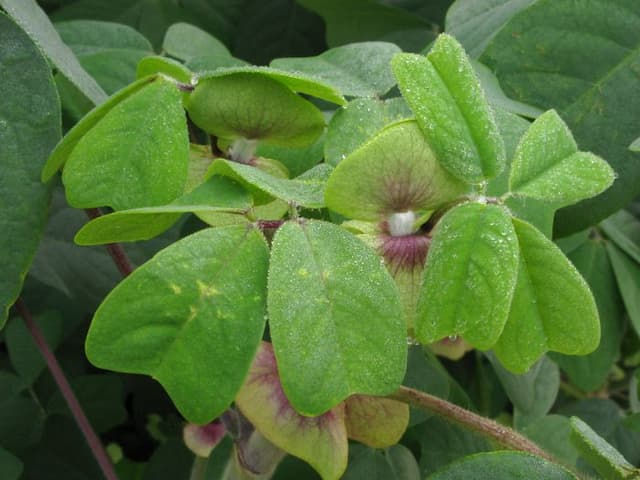Lord Anson's Pea Lathyrus nervosus

ABOUT
The common name for Lathyrus nervosus is the Lord Anson's Pea. This plant is characterized by its twining growth habit, and it often uses tendrils to climb and support itself on other vegetation. The stems are typically slender and can be either smooth or slightly hairy. Its leaves are pinnate with leaflets in pairs and possess a terminal tendril which aids in climbing. The flowers of Lord Anson's Pea are striking, typically blue or purplish in color, and form a beautiful contrast with the green foliage. They are arranged in racemes, which is a cluster where the flowers are on short stalks and arranged along a central stem. Each flower has a typical pea-like shape with a standard, wings, and keel, which is common in flowers of the legume family. After the flowering period, the plant produces fruit in the form of a pod, which carries its seeds. These pods can vary in color and texture depending on their maturity, often starting green and becoming brown as they ripen. Overall, Lord Anson's Pea's distinct climbing habit, paired with its attractive foliage and blossoms, makes it a noteworthy addition to gardens where it can freely twine onto supports or spread across the ground in areas where size containment is not a primary concern.
About this plant
 Names
NamesFamily
Fabaceae
Synonyms
Lord Anson's Pea, Winter Vetchling, Narrow-Leaved Everlasting Pea
Common names
Orobus nervosus, Lathyrus monanthos
 Toxicity
ToxicityTo humans
Lathyrus nervosus, commonly known as Lord Anson's pea, contains toxic amino acids, particularly a compound called ODAP (β-N-oxalyl-L-α,β-diaminopropionic acid), which can lead to a neurological disorder if consumed in large quantities over a prolonged period. This condition, known as lathyrism, affects the motor neurons and can cause symptoms including muscle weakness, paralysis, and potentially irreversible limb paralysis if the ingestion is not stopped. However, occasional consumption in small amounts is unlikely to cause acute poisoning.
To pets
Lathyrus nervosus, or Lord Anson's pea, may also be toxic to pets, such as cats and dogs, due to the presence of the same amino acids that are harmful to humans. Symptoms of lathyrism in pets include lethargy, lack of coordination, muscle tremors, and potentially paralysis with prolonged ingestion. The severity of the symptoms can vary based on the amount of the plant ingested and the length of the exposure. Pet owners should be cautious and avoid allowing their animals to ingest this plant.
 Characteristics
CharacteristicsLife cycle
Perennials
Foliage type
Deciduous
Color of leaves
Green
Flower color
Blue
Height
2-3 feet (0.6-0.9 meters)
Spread
2 feet (0.6 meters)
Plant type
Climber
Hardiness zones
5
Native area
South America
Benefits
 General Benefits
General Benefits- Ornamental Value: Lathyrus nervosus, commonly known as the Lord Anson's pea, is often grown for its attractive flowers and overall appearance, enhancing the aesthetic appeal of gardens and landscapes.
- Nitrogen Fixation: Like other legumes, Lord Anson's pea has the ability to fix nitrogen in the soil through its symbiotic relationship with rhizobia bacteria, thereby improving soil fertility.
- Wildlife Attraction: The flowers of Lord Anson's pea can attract pollinators such as bees and butterflies, which are essential for the pollination of many plants.
- Food Source: Although not commonly consumed, the seeds and young shoots of Lord Anson's pea may have been historically used as a source of food by indigenous peoples in its native habitat.
- Cover Crop: Due to its nitrogen-fixing abilities, Lord Anson's pea can be used as a cover crop to improve soil quality between plantings in agricultural settings.
 Medical Properties
Medical PropertiesThis plant is not used for medical purposes.
 Air-purifying Qualities
Air-purifying QualitiesThis plant is not specifically known for air purifying qualities.
 Other Uses
Other Uses- Lathyrus nervosus, commonly known as Lord Anson's Pea, is often used as a natural dye source, with parts of the plant yielding different shades for wool, cotton, and silk fabrics.
- The dried stems of Lord Anson's Pea can be woven into baskets and other handicrafts due to their length and pliability.
- The plant can be used in garden design for its climbing habit, providing vertical interest or natural screens when grown on trellises.
- The flowers of Lord Anson's Pea can be pressed and used in botanical art and crafts for their attractive blue-violet hues and intricate shapes.
- Seed pods from the plant can be used in dry floral arrangements, adding a unique texture and shape to the composition.
- Due to its ability to fix nitrogen, Lord Anson's Pea can be planted to improve soil fertility in garden beds without the need for chemical fertilizers.
- Gardeners might utilize the plant as a companion plant, as it may deter certain pests through its natural aroma and physical presence.
- The robust roots of Lord Anson's Pea can help stabilize loose soil, making it useful for erosion control in certain landscapes.
- When dried, the seeds of the plant can be used in decorative crafts, such as creating mosaics or as fillers for rattles and musical instruments.
- Fine fibers from the plant have potential to be studied for their usability in making paper or lightweight textiles.
Interesting Facts
 Feng Shui
Feng ShuiThe Blue Sweet Pea is not used in Feng Shui practice.
 Zodiac Sign Compitability
Zodiac Sign CompitabilityThe Blue Sweet Pea is not used in astrology practice.
 Plant Symbolism
Plant Symbolism- Enduring Beauty: Often referred to as "Lord Anson's pea," Lathyrus nervosus is admired for its striking blue flowers and can symbolize a beauty that withstands the test of time.
- Lasting Pleasure: As a perennial plant, the Lord Anson's pea returns each year with fresh blooms, representing the idea that enjoyment and happiness can be recurring and long-lasting.
- Blissful Relationships: The pea family is often associated with strong, positive relationships, and Lathyrus nervosus may thus symbolize a blissful and harmonious connection with others.
- Strength Amidst Adversity: Able to grow in various conditions, Lord Anson's pea embodies the ability to remain strong and vibrant even when faced with challenging environments.
 Water
WaterLord Anson's pea prefers consistent moisture, so water when the top inch of the soil feels dry. This typically translates to watering once a week, but may vary depending on environmental conditions. Provide about 1 gallon of water for outdoor plants or enough to thoroughly wet the soil for potted specimens without causing standing water. In hotter, drier periods water may be needed twice a week, while in cooler, wetter months, watering frequency should decrease to prevent waterlogging.
 Light
LightLord Anson's pea thrives in full sun to partial shade. The best spot for the plant is one where it receives at least 6 hours of direct sunlight a day, but is protected from the harsh afternoon sun in very hot climates. Filtered light or a spot with morning sun and afternoon shade is ideal to encourage vigorous growth and blooming.
 Temperature
TemperatureLord Anson's pea tolerates a wide range of temperatures but performs best when the temperature is between 60 and 75 degrees Fahrenheit. The plant can survive minimum temperatures of around 50 degrees Fahrenheit and maximum temperatures up to about 85 degrees Fahrenheit. Avoid placing the plant in locations where temperature extremes are common, as this can hinder growth and flowering.
 Pruning
PruningPruning Lord Anson's pea is important to maintain shape and encourage bushier growth. Prune in the late winter or early spring before new growth begins. Remove dead or weak stems, and cut back the plant by about one third. This helps to stimulate new growth and allows for a fuller plant. Annually pruning ensures healthy plants and optimizes flowering.
 Cleaning
CleaningAs needed
 Soil
SoilFor Lord Anson's Pea, prepare a well-draining soil mix with compost and loamy soil, ensuring good aeration. The ideal soil pH for this plant should be slightly acidic to neutral, in the range of 6.0 to 7.0.
 Repotting
RepottingLord Anson's Pea should be repotted every 1-2 years or when it outgrows its current container, to ensure continued growth and to replenish nutrients in the soil.
 Humidity & Misting
Humidity & MistingLord Anson's Pea thrives in moderate humidity levels, similar to what is typically found in a home environment. Aim for a humidity level around 40-60% for optimal growth.
 Suitable locations
Suitable locationsIndoor
Provide bright, indirect light and consistent moisture for indoor Lord Anson's Pea.
Outdoor
Choose a sunny spot and plant after the last frost for outdoor Lord Anson's Pea.
Hardiness zone
5-9 USDA
 Life cycle
Life cycleLathyrus nervosus, commonly known as Lord Anson's Pea, commences its life cycle as a seed, which, under suitable conditions of moisture and temperature, germinates and forms a radicle that will grow into the root system. The seedling then emerges from the soil, developing its first set of true leaves and begins photosynthesis. As the plant matures, it develops a robust stem and foliage through vegetative growth, along with climbing tendrils that allow it to secure itself to structures or other plants for support. The Lord Anson's Pea progresses to the flowering stage, exhibiting typically blue to purple flowers which, when pollinated, result in the formation of pods containing seeds. These seeds are then dispersed by various means, such as wind or animal movement, and once in suitable conditions, the cycle begins again with germination. The plant is a perennial, meaning it can live for several years, with the vegetative and flowering stages repeating annually after the initial establishment.
 Propogation
PropogationPropogation time
Spring
Propogation: Lord Anson's pea, commonly known as Lathyrus nervosus, is mainly propagated through seed. The ideal time to sow the seeds is in spring, after the danger of frost has passed, when soil temperatures are around 60-70°F (15.6-21.1°C). To aid germination, it is recommended to scarify the seeds by lightly nicking the seed coat with a file or using sandpaper, or to soak them in water for 24 hours. Sow the seeds about an inch deep into well-draining soil and space them approximately 2 inches (5 cm) apart. They prefer a sunny location and typically germinate within 2 to 3 weeks. Once the seedlings have developed a few sets of true leaves and are strong enough, they should be thinned or transplanted to allow for adequate space for growth.









